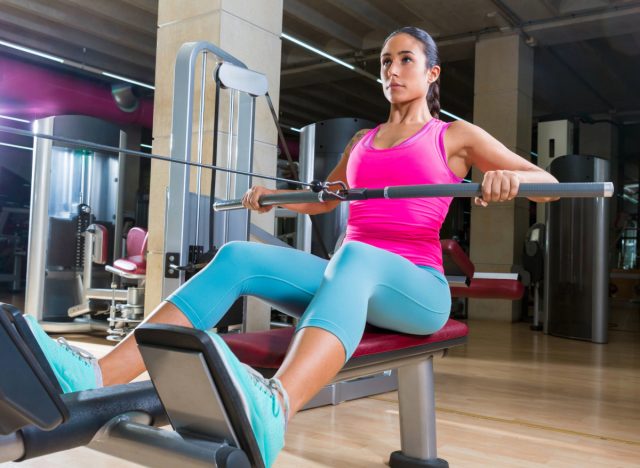When it comes to increasing muscle size, not all workout plans are the same. The push-pull training program is a well-established technique that is popular among fitness enthusiasts and bodybuilders. This method involves splitting your workouts into days that focus on pushing exercises (such as bench press, shoulder press, squats, and lunges) and days that emphasize pulling movements (like rows, pull-ups, deadlifts, and glute bridges). By following this approach, you create a well-rounded workout routine that targets all major muscle groups effectively.
Regardless of your current fitness level, adapting your workout routine to incorporate the push-pull strategy can lead to significant muscle gains. This strategy not only optimizes muscle development but also helps prevent injuries by allowing adequate rest periods for each muscle group.
If you are looking for a reliable way to upgrade your fitness regime, look no further. With my extensive experience as a certified strength and conditioning specialist (CSCS) and more than ten years of coaching background, I assure you that the push-pull method is highly effective. Let’s explore its advantages, principles, and even a sample workout to kickstart your journey towards achieving maximum muscle growth.
Benefits of Performing a Push-Pull Workout

The push-pull workout method stands out for its simplicity and effectiveness. By categorizing exercises into push and pull movements, you ensure a balanced development of your muscles. This method allows you to target major muscle groups without overlapping, giving each group adequate rest and recovery time.
Additionally, push-pull workouts are incredibly versatile, allowing for customization based on your fitness level, goals, and schedule. Another significant benefit is the potential for increased frequency. Since you’re alternating between push and pull days, you can train more often without the risk of overtraining. This increased frequency can lead to more significant muscle hypertrophy and strength gains.
Plus, push-pull workouts are time-efficient. Instead of spending hours figuring out which exercises to do, you have a clear plan that keeps you focused and on track.
How a Push-Pull Workout Can Help You Build Muscle

The push-pull workout method is a game-changer when it comes to building muscle. By focusing on specific muscle groups each session, you can push each group to its limit, knowing it will have time to recover before hitting it again.
To maximize muscle growth, aim for three to four sets per exercise with a rep range of eight to 12 reps. This range is the sweet spot for hypertrophy, or muscle building, as it provides the right balance of intensity and volume. High intensity ensures you’re challenging your muscles enough to stimulate growth, while sufficient training volume accumulates enough total work to promote adaptation.
This structured approach helps maintain the necessary high intensity and volume in your workouts, which are key ingredients for muscle growth.
A Sample Push-Pull Workout for Maximum Muscle Growth
As promised, here’s a refined sample workout utilizing the push-pull method to help you define your physique. This workout gives you four muscle-building training days: an upper and lower push day and an upper and lower pull day.
Upper-body Push Day

Warm-up:
- 5 to 10 minutes of light cardio
- 5 to 10 minutes of dynamic stretches
Upper-body Push Exercises:
- Bench Press: 4 sets of 8-10 reps
- Overhead Shoulder Press: 4 sets of 8-10 reps
- Incline Dumbbell Press: 3 sets of 10-12 reps
- Tricep Dips: 3 sets of 10-12 reps
- Lateral Raises: 3 sets of 12-15 reps
- Tricep Pushdowns: 3 sets of 12-15 reps
Lower-body Push Day

Warm-Up:
- 5 to 10 minutes of light cardio
- 5 to 10 minutes of dynamic stretches
Lower-body Push Exercises:
- Squats: 4 sets of 8-10 reps
- Leg Press: 3 sets of 10-12 reps
- Lunges: 3 sets of 10-12 reps (each leg)
- Calf Raises: 4 sets of 12-15 reps
Upper-body Pull Day

Warm-up:
- 5 to 10 minutes of light cardio
- 5 to 10 minutes of dynamic stretches
Upper-body Pull Exercises:
- Pull-ups: 4 sets of 6-8 reps
- Bent-over Rows: 4 sets of 8-10 reps
- Face Pulls: 3 sets of 12-15 reps
- Seated Cable Rows: 3 sets of 10-12 reps
- Bicep Curls: 3 sets of 12-15 reps
- Hammer Curls: 3 sets of 12-15 reps
Lower-body Pull Day

Warm-up:
- 5 to 10 minutes of light cardio
- 5 to 10 minutes of dynamic stretches
Lower-body Pull Exercises:
- Deadlifts: 4 sets of 6-8 reps
- Romanian Deadlifts: 3 sets of 10-12 reps
- Hamstring Curls: 3 sets of 12-15 reps
- Glute Bridges: 4 sets of 12-15 reps
Tips for Maximum Growth

To maximize your muscle growth, following a few fundamental principles is essential.
- Practice progressive overload by gradually increasing your weights or resistance to continually challenge your muscles. You can do this by adding more weight, increasing the number of reps, or adjusting the tempo of your exercises.
- Maintain proper form to prevent injuries and effectively target the intended muscles.
- Prioritize rest and recovery by getting enough rest between workouts and sufficient sleep to allow your muscles to recover and grow.
- Fuel your body with a balanced diet of protein, healthy fats, and complex carbohydrates to support muscle growth.
Frequently Asked Questions (FAQs)
1. What is a push-pull workout?
A push-pull workout is a type of training split that divides exercises based on the movement pattern. Push exercises involve movements where you push weight away from your body, like bench press and shoulder press. Pull exercises involve movements where you pull weight towards your body, like rows and pull-ups.
1.1. Why is it effective for muscle growth?
A push-pull workout allows specific muscle groups to rest while you work others, leading to more balanced training sessions and potentially better strength gains and muscle growth.
2. How should I structure my push-pull workout for muscle growth?
When structuring your push-pull workout for muscle growth, aim to include compound exercises that target multiple muscle groups in each session. Alternate between push and pull days to allow for adequate recovery for specific muscle groups.
2.1. Can you provide an example of a push-pull workout split?
Sure! Here’s an example of a push-pull workout split:
- Push Day: Bench Press, Shoulder Press, Tricep Dips
- Pull Day: Deadlifts, Pull-Ups, Rows
Remember to include both compound and isolation exercises to target muscle groups from different angles for optimal muscle growth.
3. How many days per week should I do a push-pull workout?
The frequency of your push-pull workouts depends on your training experience, recovery ability, and overall fitness goals. Beginners may start with 2-3 sessions per week, while more advanced lifters can do 4-5 sessions. Listen to your body and adjust the frequency accordingly.
3.1. Should I include rest days in between push-pull workouts?
Yes, it’s advisable to include rest days or active recovery days in between push-pull workouts to allow for muscle repair and growth. Overtraining can hinder your progress, so adequate rest is crucial for optimal results.






